Note that the seller changed the images on his website after I published this report
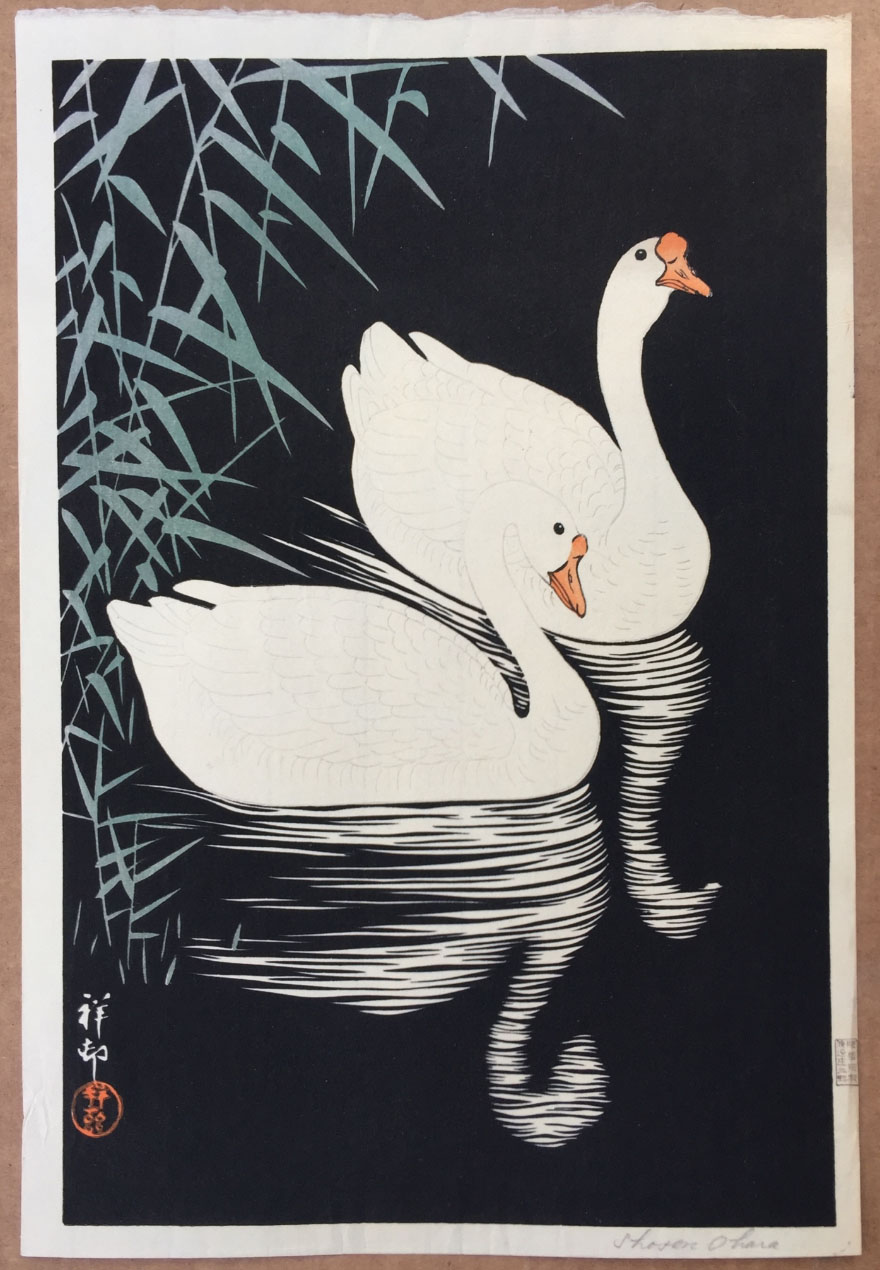
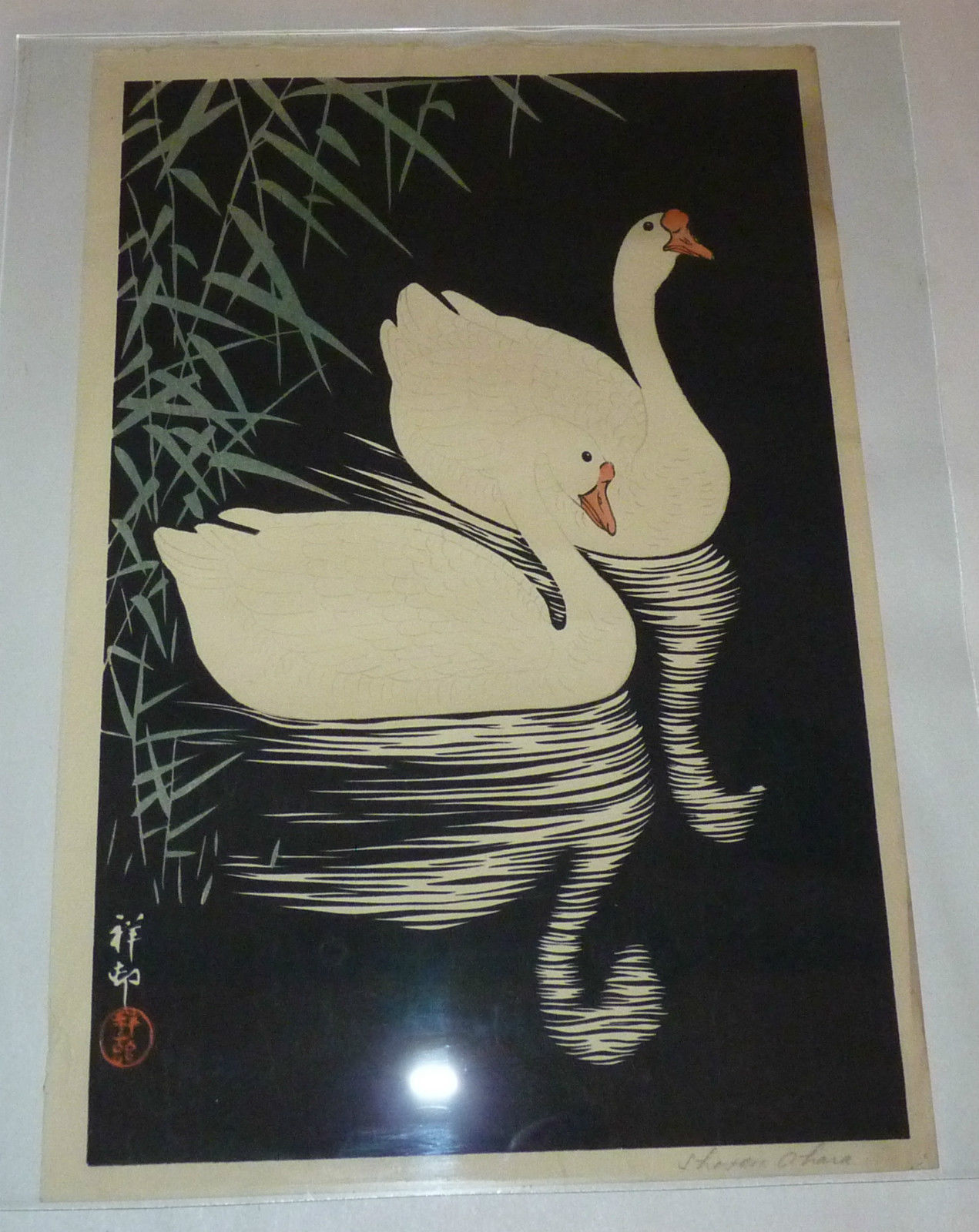
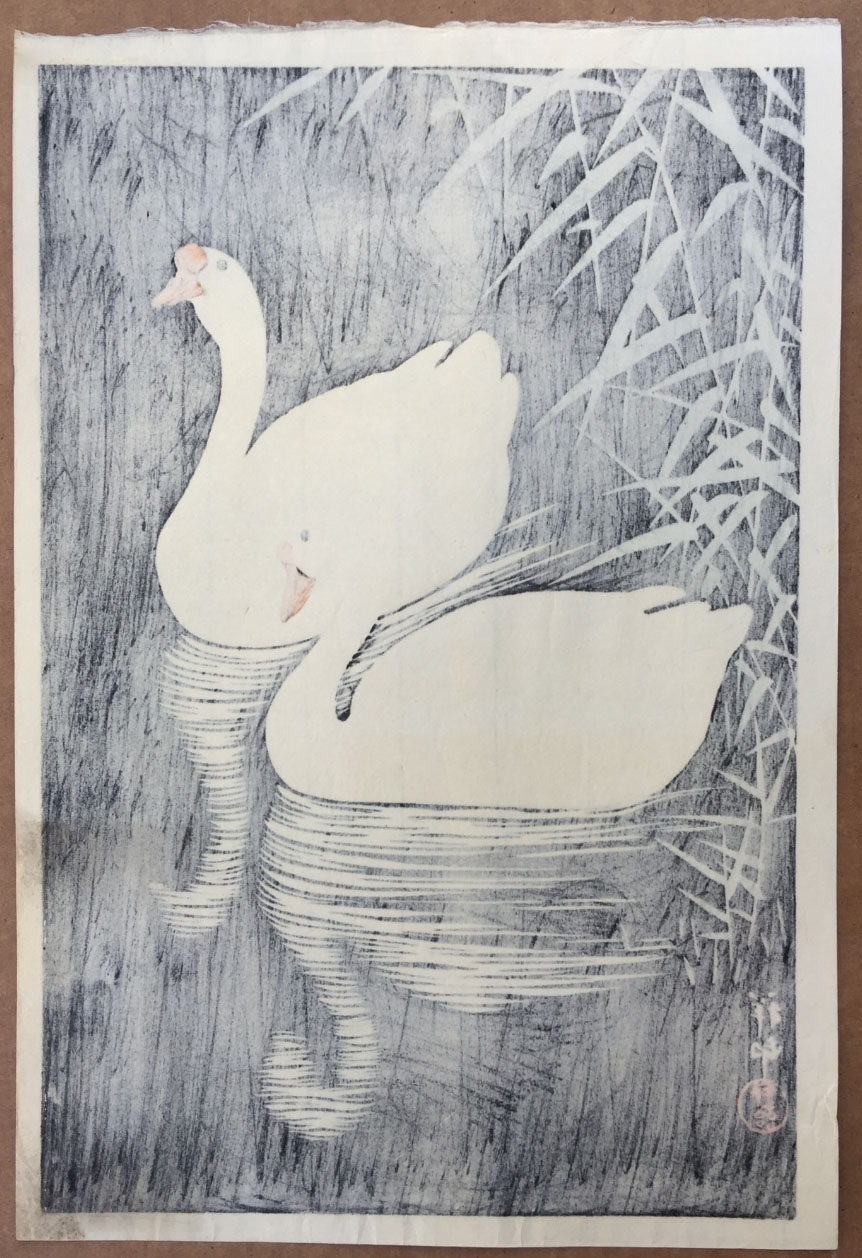
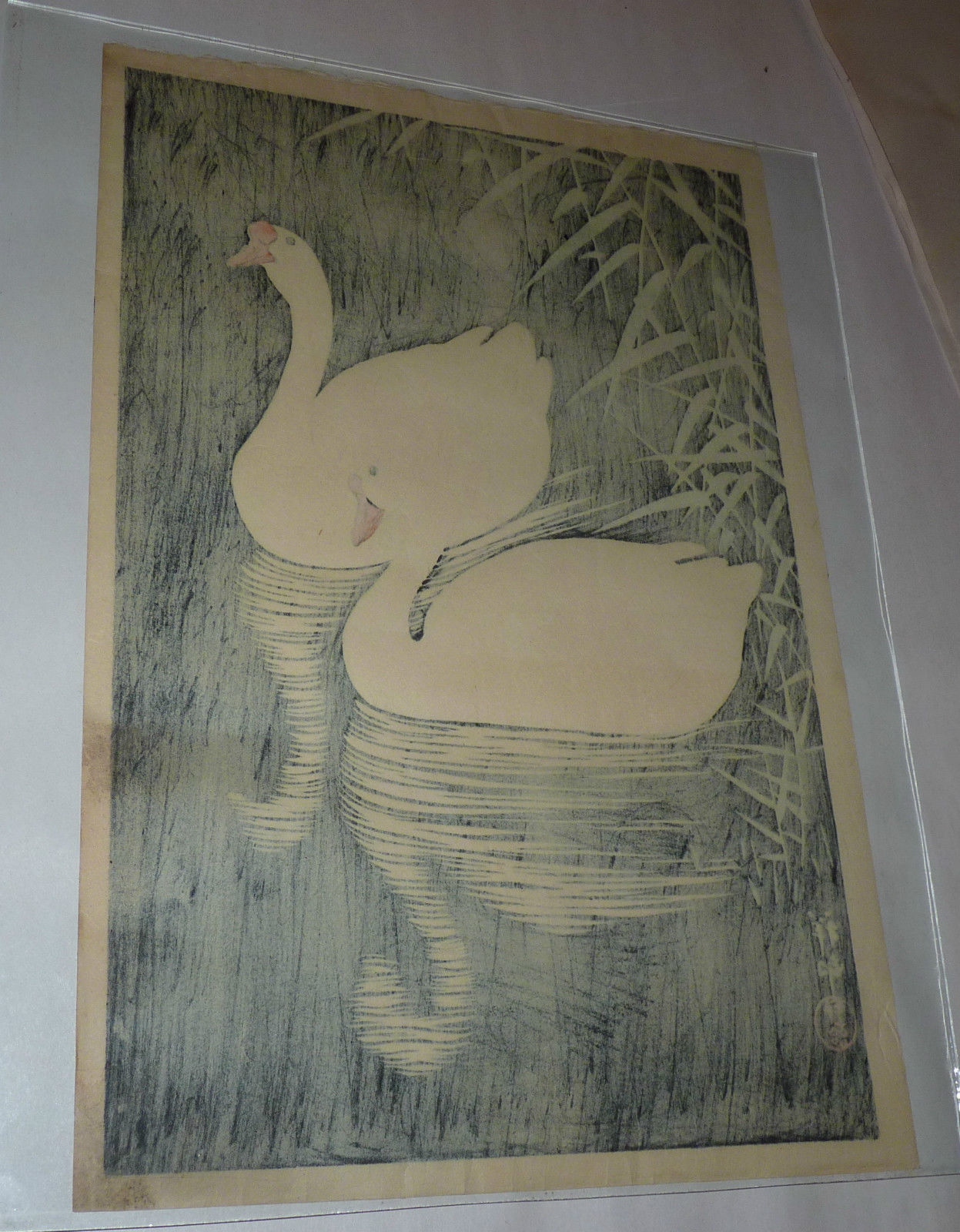
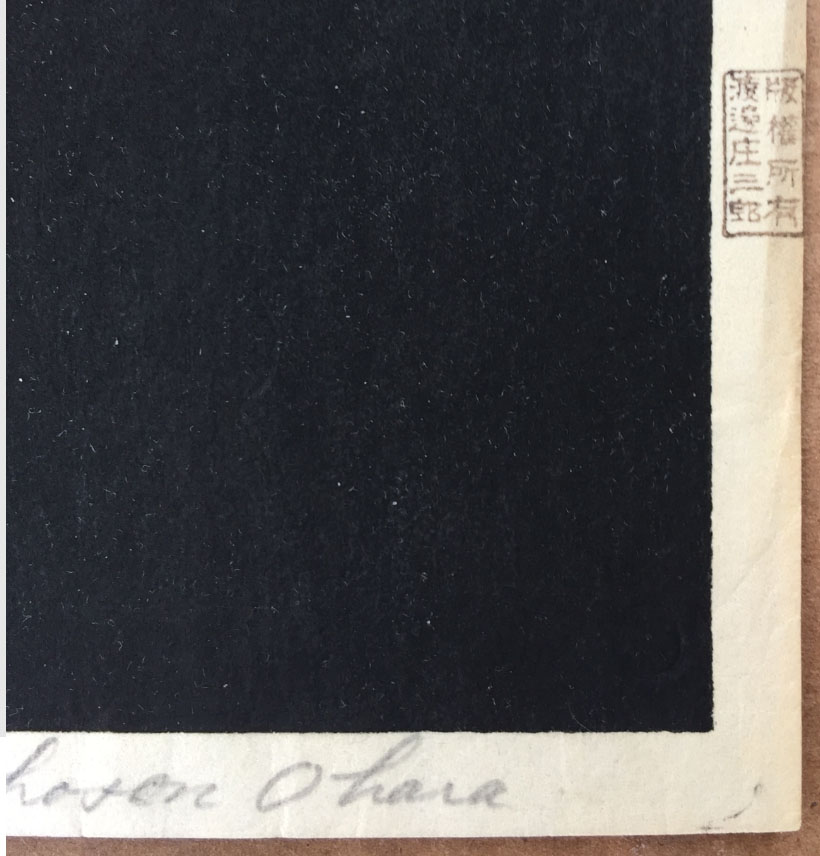
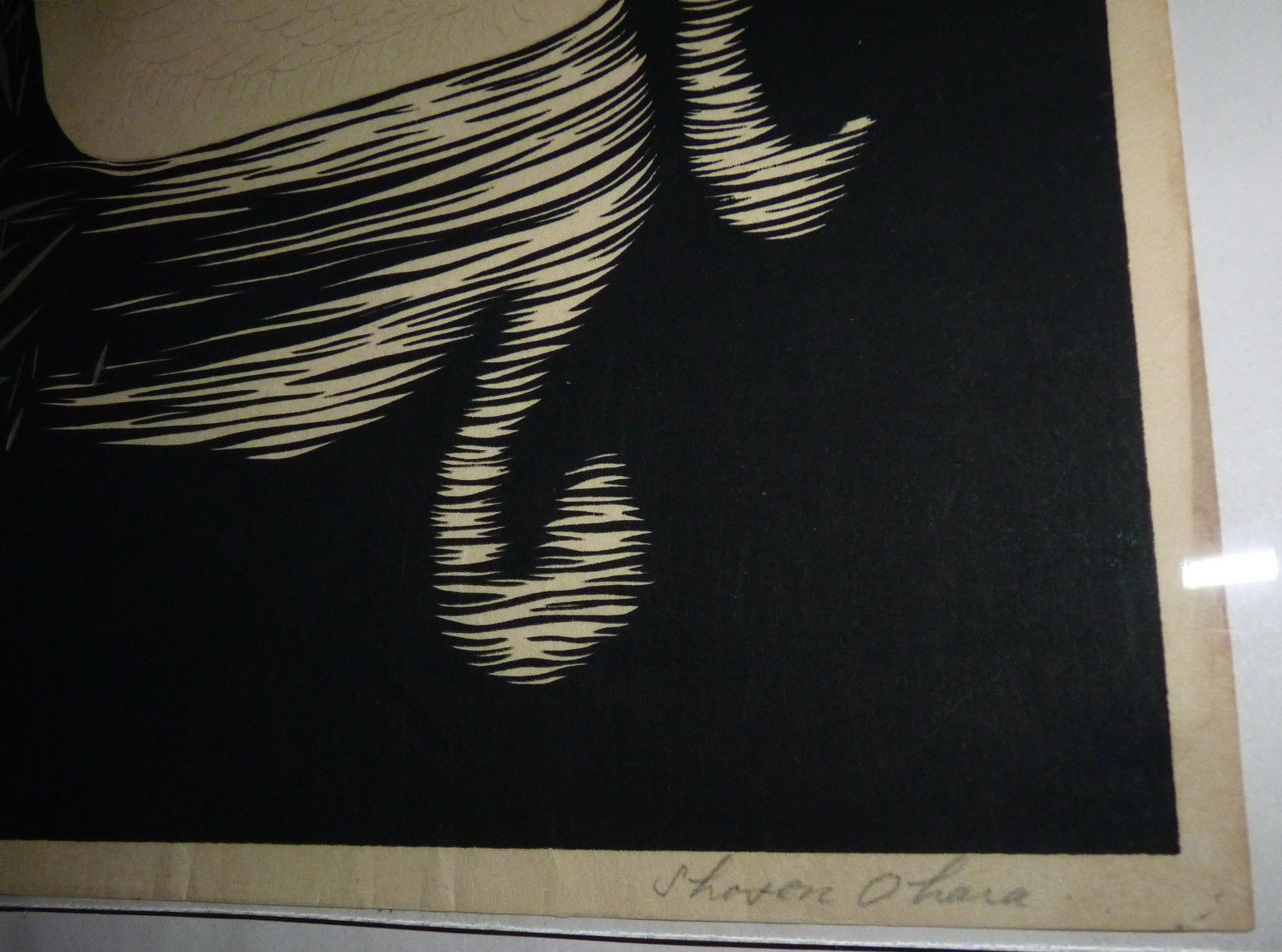
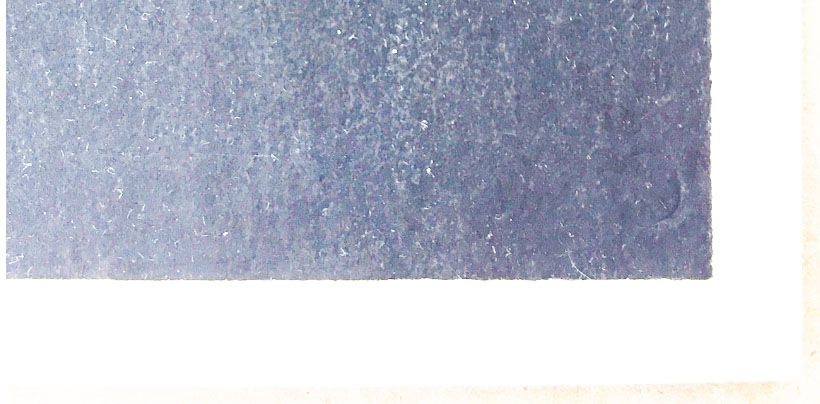
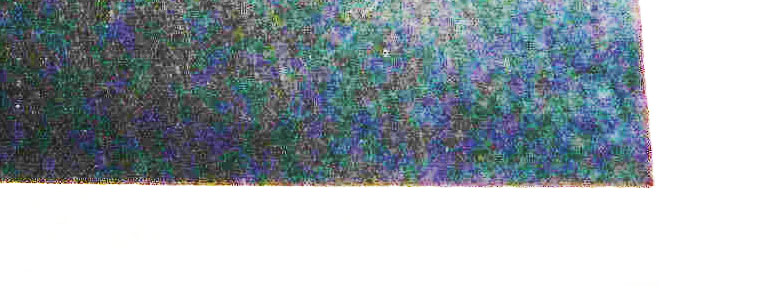
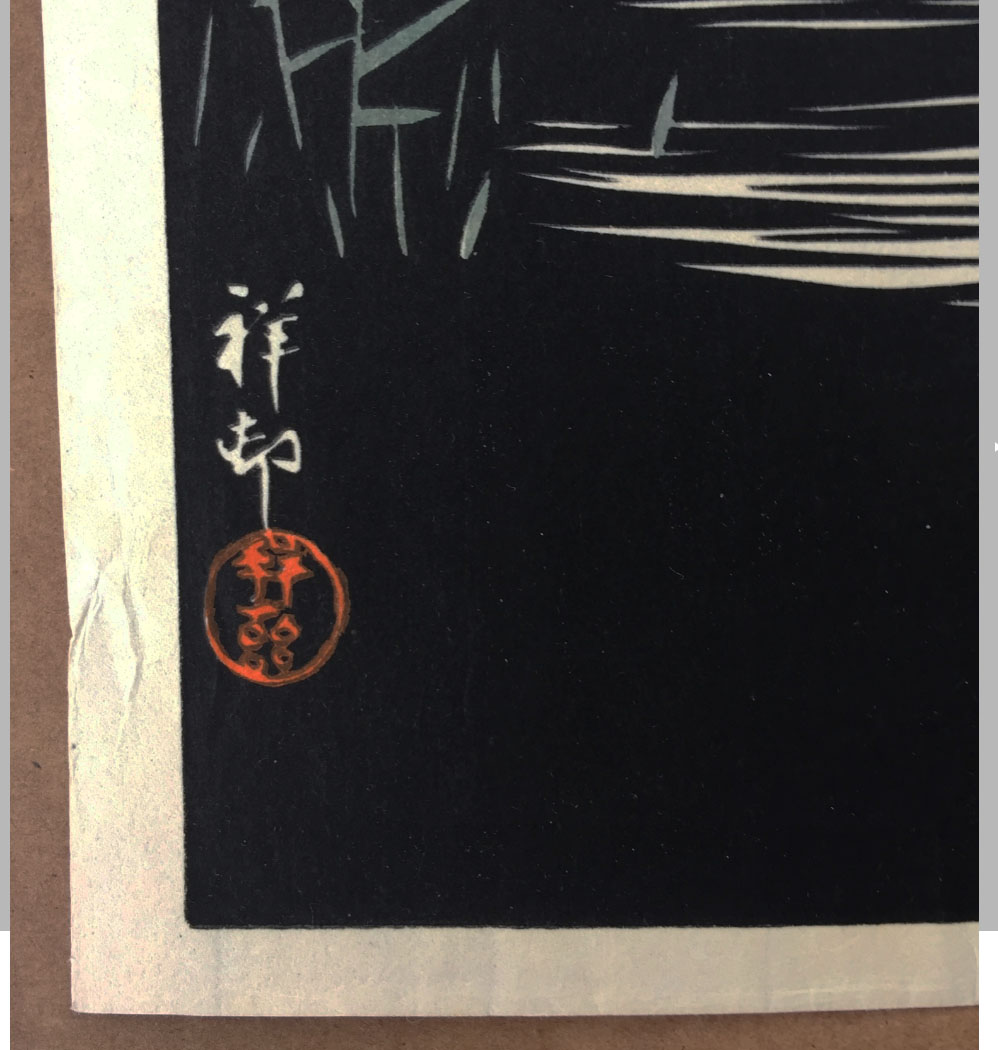
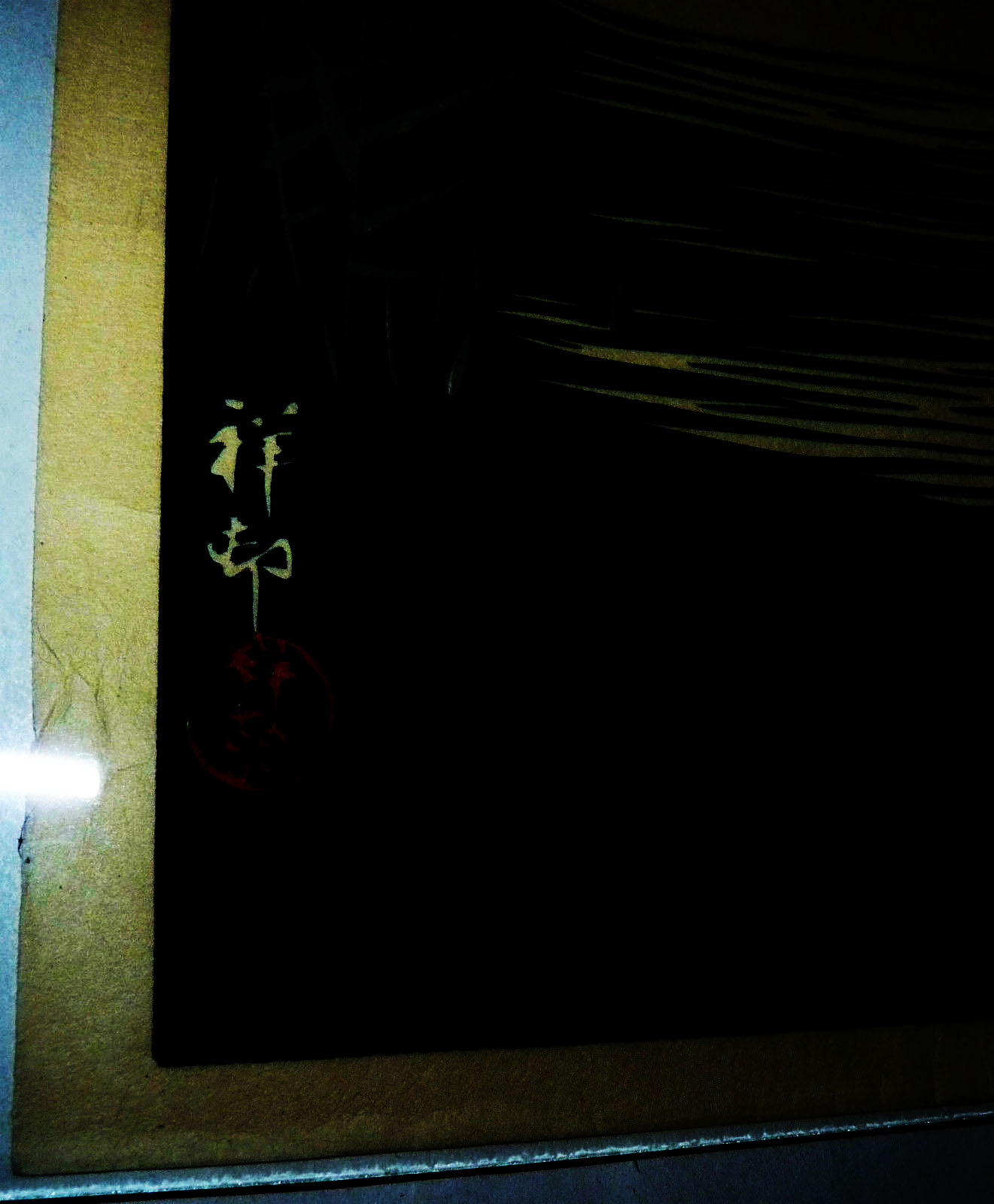
I was recently contacted by a concerned Japanese print collector regarding prints sold on eBay later appearing on a dealer website with what one might describe as "modifications" and being sold as earlier editions. Perhaps there is a valid explanation for how a Watanabe A seal can suddenly appear on a print that recently sold on eBay without the seal? Or a Hasui print suddenly gaining a Watanabe C seal? Could it be "magic"? Note that the Shoson print already has a Watanabe 6mm seal in the lower right corner; I've enhanced the images to show the seal more clearly. The listings of the Shoson print are on the dealer website here (backup copy here, note that the seller changed the images on his website after I published this report) and on eBay here. You might like to save a copy of the listings in case they disappear. There is evidence to suggest the winner of these eBay prints was indeed the dealer concerned.
| Woodblock Print World print Note that the seller changed the images on his website after I published this report |
eBay print | |
| Front. Notice that the Woodblock Print World's print margin now contains a Watanabe A seal! Note also the exact same tone line in the right margin, and the exact same pencil signature. |  |
 |
| Verso showing the exact same baren markings and margin soiling. |  |
 |
| Note the pencil signatures are the same, as is the tone line in the margin. The Watanabe A seal appears to be a new edition to the print. |  |
 |
| Note that both prints have a Watanabe 6mm seal (enhanced images) in exactly the same location with the same embossed patterning. |  |
 |
| Creasing in the lower left margin is exactly the same (note: I enhanced the images for ease of viewing). |  |
 |
Here is another example of an eBay print that appears to have been "modified" by perhaps Photoshop'ing out the creases (or soaking the print to remove them) and adding a Watanabe C seal. Fortunately for the dealer, this print did not have a pesky Watanabe 6mm seal to hide, so it was easier to make it look like a pre-war edition. Note that the print is listed as: "Date of this edition: 1931, 1st edition", despite the fact it is most likely a post-war edition. The listings of this print are on the dealer website here (backup copy here) and on eBay here. You might like to save a copy of the listings in case they disappear.
| Woodblock Print World print Note that the seller changed the images on his website after I published this report. |
eBay print | |
| Front. Note that the Woodblock Print World print now has a Watanabe C seal in the right margin. | 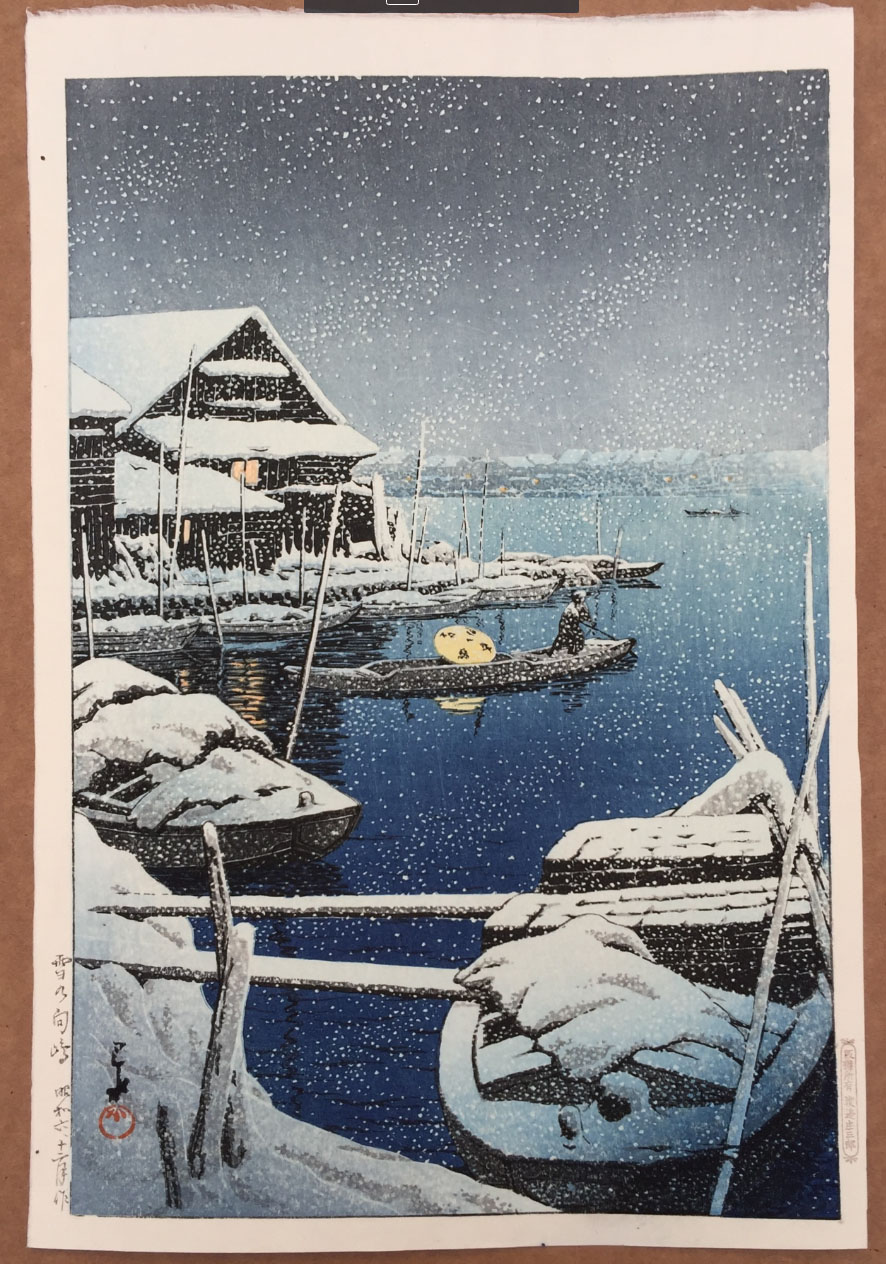 |
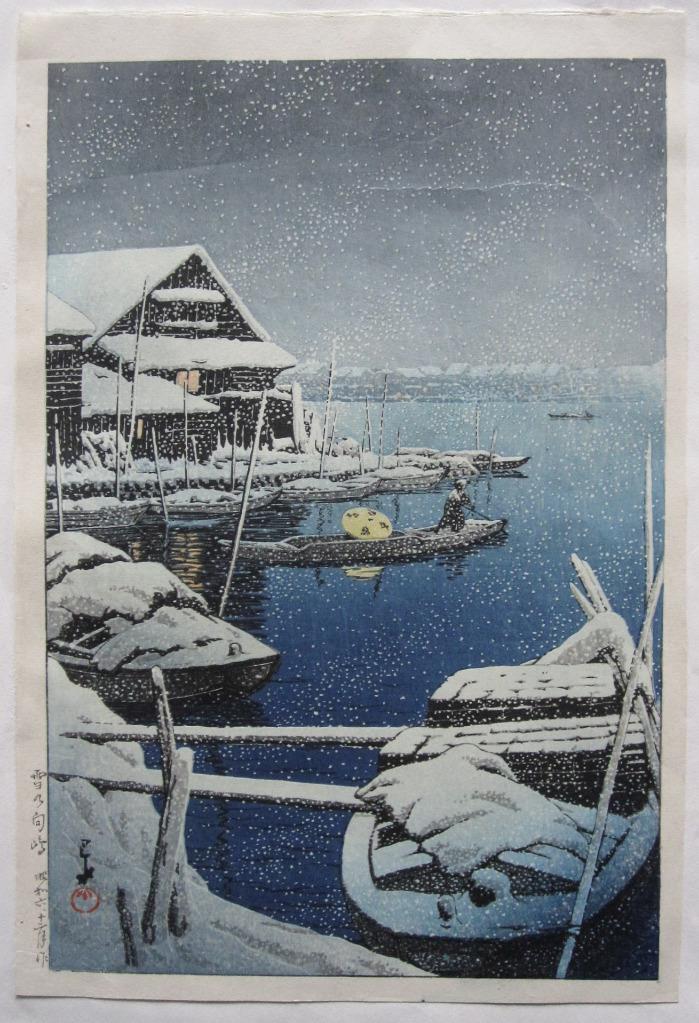 |
| The verso, showing the exact same barren markings, and the same dark ink bleed-through at the bottom left of the image. | 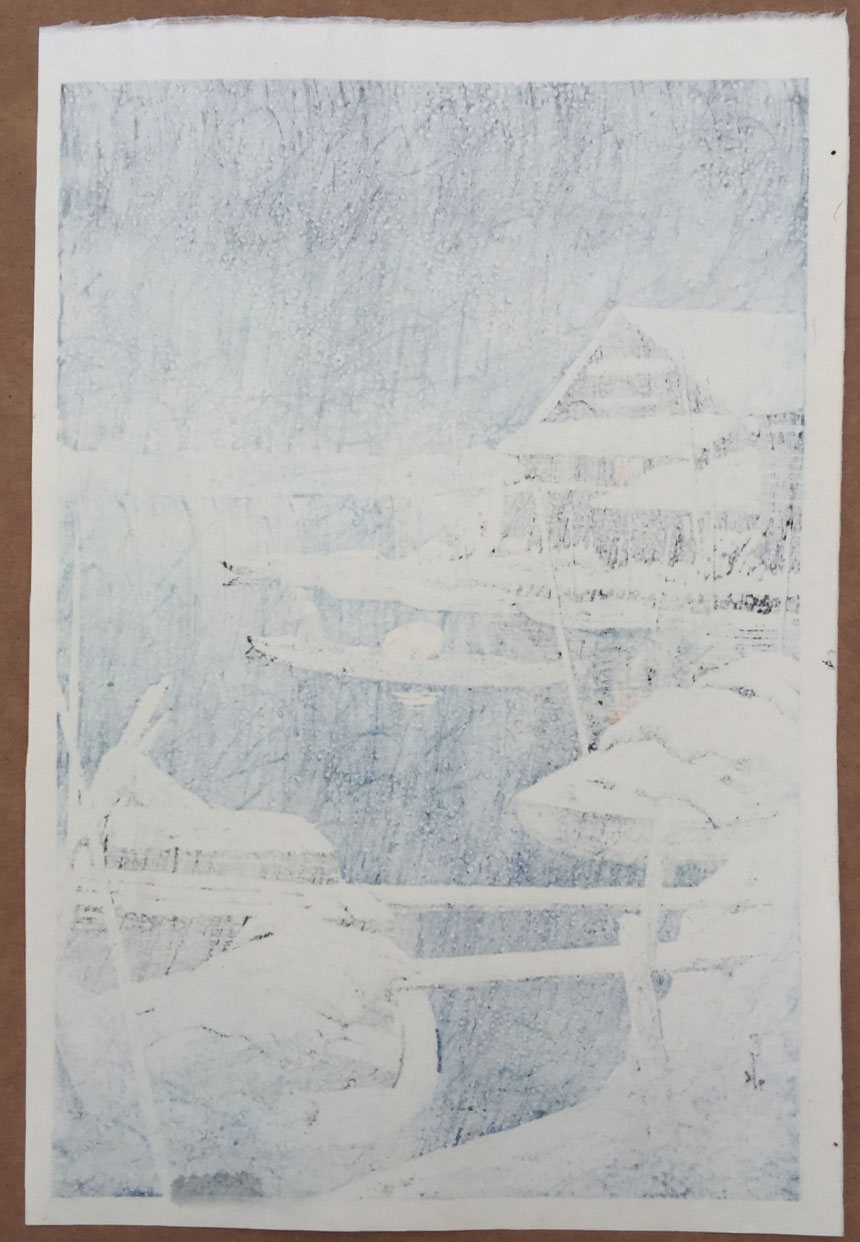 |
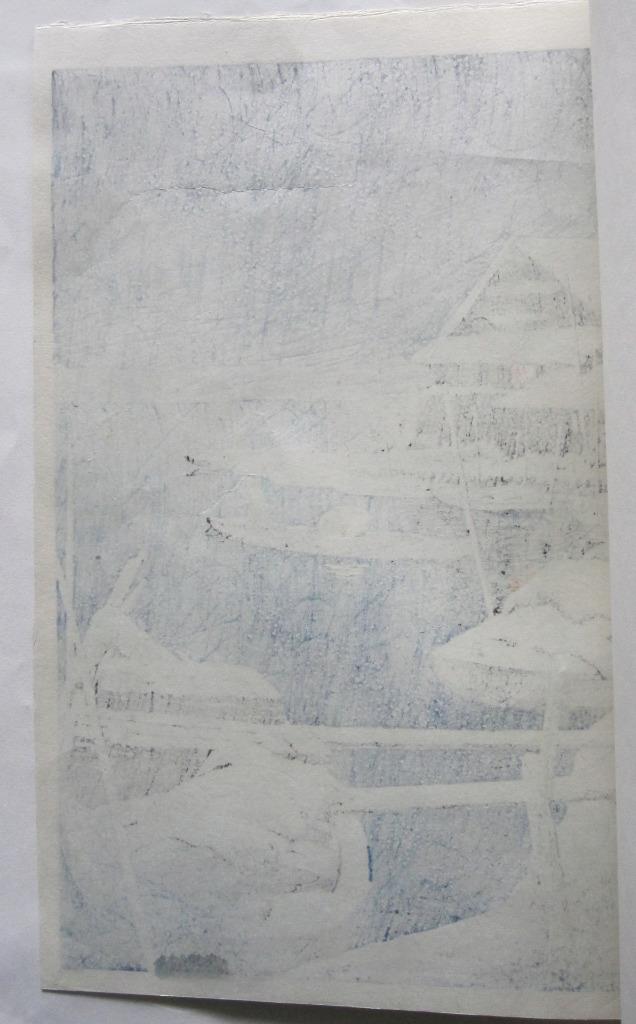 |
| Note the same location of the black ink stain at upper left (almost impossible to be a coincidence) and the same location for the paper drying hole at lower left. | 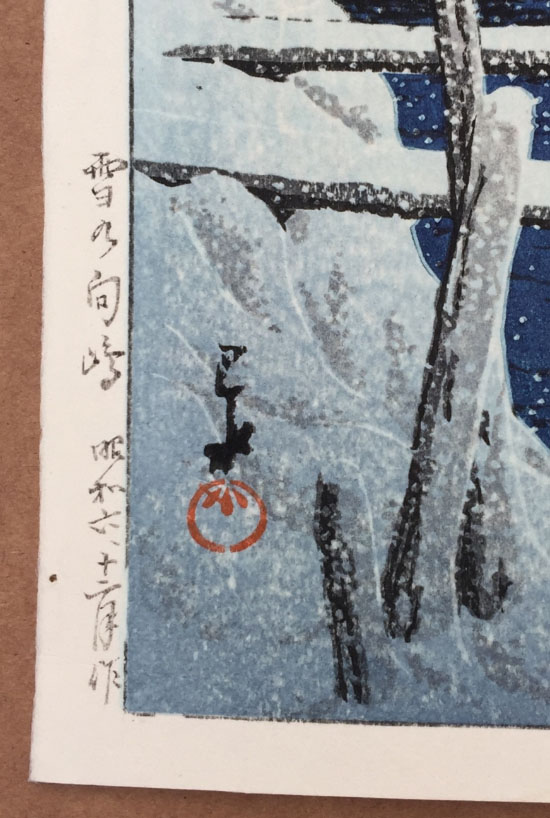 |
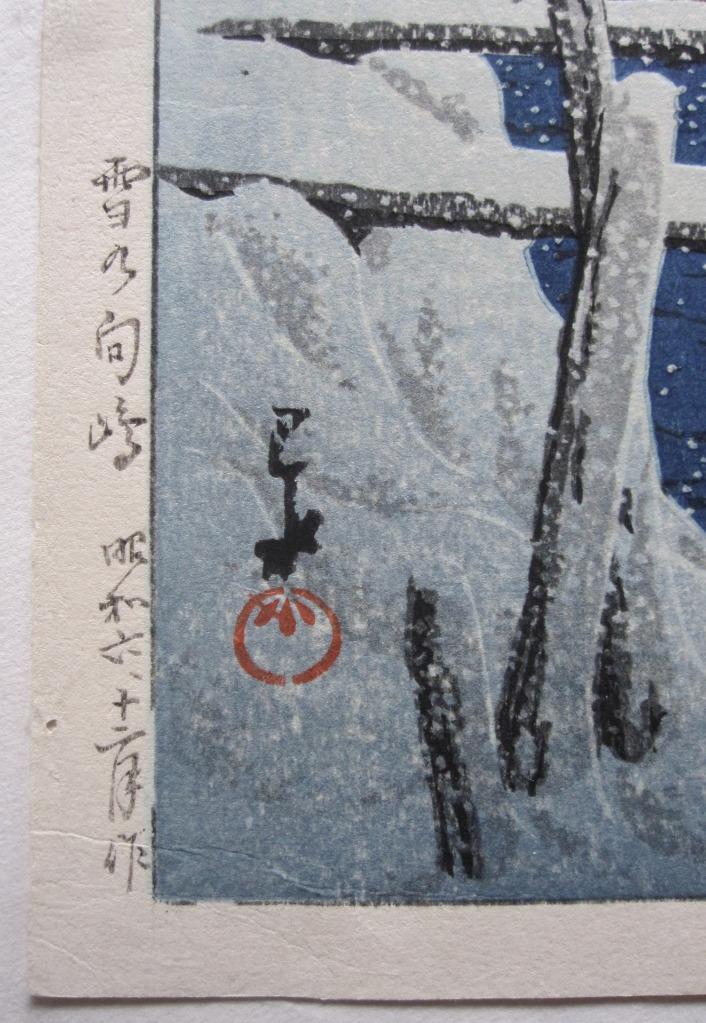 |
As I expected, the dealer has now removed the Shoson print from his website, instead replacing it with a link to a blog that accuses me of fabricating the results of my research work on Tsuchiya Koitsu. He also changed the images of the Hasui Mukojima print on the Woodblock Print World website to that of a different print. Please compare the new images on the website with those on this webpage that I downloaded from Woodblock Print World 24-hours ago. Note that the switched images now show a print with matte tone lines. Update: he has once again changed the image to show a different print.
Fortunately I have PDF copies of both web-pages from yesterday, prior to the dealer "hiding the evidence" (see links below). I guess we can also expect to see even more accusations directed at me in the future from this dealer.
In a private email to me, the dealer of Woodblock Print World, Stephane Jardonnet, claimed that a "teenager" in his area sold him the fake prints. However, the purchaser of the prints was eBay member "l***e". This username loosely fits that of "lilyrose987", the username used by Stephane Jardonnet, and this can be confirmed by viewing this print on eBay (backup copy here). Note that this print is currently (February 20, 2017) also being sold on Woodblcok Print World here (backedup copy here). If you view "eBay Member User ID History" you will see that "lilyrose987" was changed from "magicsteph1" in December 2015. Note that Stephane Jardonnet is also a magician by trade. So with little doubt the prints with forged seals were purchased by Stephane Jardonnet, not a 3rd party (see the February 21st update below, where the eBay seller confirms the buyer of one of the prints was "lilyrose987").
Stephane claims that I posted this information as a "vendetta" against him, but at the time of posting I did not know who the owner of Woodblock Print World was, and furthermore, the link to this web-page was not released publicly; it was only sent to my fellow print dealers and my clients. It was thanks to my dealer colleagues that the link to Stephane was made. I don't have a "vendetta" against Stephane, but I and my dealer colleagues do take unkindly to, and will expose, any seller that forges or doctors Japanese artworks.
Update February 21st:
I have now received confirmation from one of the two eBay sellers who sold prints to the dealer that yes indeed, the purchaser was eBay member "lilyrose987". The seller even mentioned the dealer's name directly: Stephane Jardonnet. So we now have conclusive proof that the prints were purchased on eBay by Stephane, doctored with forged seals, and then listed on his website. Please note that there is no suggestion at all that the eBay sellers were involved in any way with these forgeries. They are simply innocent victims, along with any customers who have purchased forged and doctored prints in the past. Here is Stephane's explanation (an extract from an email I received from him):
All 3 prints that I have from that supplier will be returned to him, and I will have a chat with him. He is a teenager, that lives in my area, and it is better to educate that person rather than punish him. Else, you should be prepared to see a lot more like that on the market, except that next time, I will not be the one being fooled.So this dealer (or his associate) is not only skilful in the art of forgery, he is also quite comfortable in telling "porky pies" when need be. Stephane's email also suggests there were more forged prints in his possession, so that is a troubling development. I did notice that after I posted this article, at least four other Hasui prints were quickly removed from the dealer's website (I have PDF copies and images). I am not suggesting they were doctored in any way (their removal could be completely coincidental and innocent of course), however the possibility is there.
Update February 23st:
I now have further evidence of forging of seals, doctoring of prints, and selling those prints to unsuspecting print collectors via the website Jasper 52 Auctions. Please note that the auction house is a completely innocent party and has nothing to do with the forgeries.
This third example of print doctoring is Hasui's Fudo Temple in Meguro. The purchaser on eBay was user "7***y", who had a feedback rating of 2390 on eBay (check here). Note that this fits the eBay ID of Stephane and note that the feedback number, 2390, is currently (February 23, 2017) the same as Stephane's eBay username "lilyrose987" (2390), you can confirm that here (backup copy here). As you can see below, the print sold on eBay has no publisher seal in the lower right margin, making it most likely a post-war strike. Now note that the print sold via Jasper52 Auctions has an added, I suggest forged, Watanabe "C" publisher seal (called the "sausage seal") in the lower right margin. Note the various marks and stains in the margins of both prints are identical. It is unfortunate that there are a good quantity of "un-sealed" Hasui prints from the 1950s and 60s, so it is a very simple matter for an unscrupulous forger to add a pre-war seal as we see here.
| Jasper52 Auction print | eBay print | |
| Front: Note that the print sold via Jasper52 (left image) now has a Watanabe C seal in the right margin. Note the marks in the print's margins that conclusively identify this print as the one purchased by the dealer on eBay (right image). | 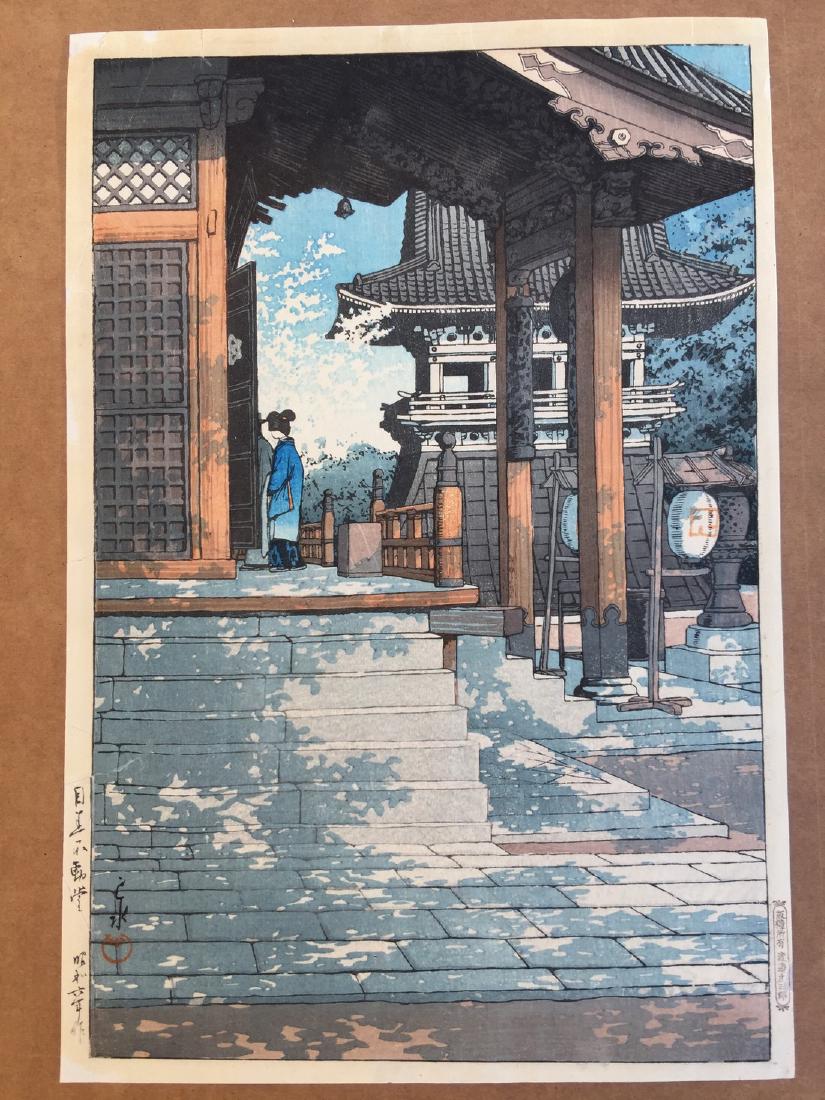 |
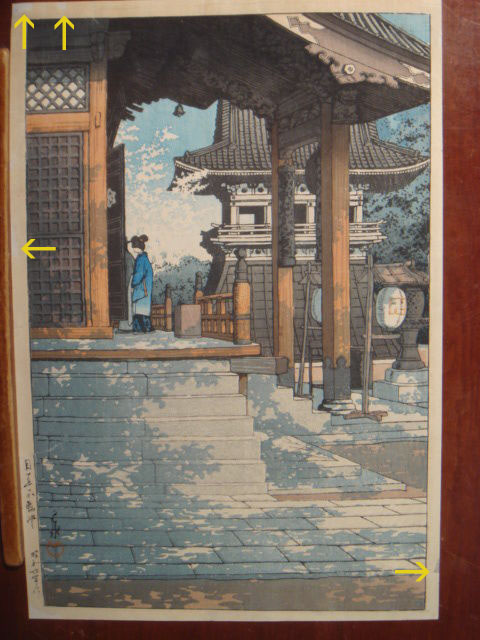 |
| Note the addition of the Watanabe C publisher seal, only used by the publisher pre-war, which falsely makes this print a first or very early edition (when in actual fact it is with little doubt a post-war strike of much lesser value). The dark mark in the lower right-hand margin is clearly the same on both the print auctioned via Jasper52 and the print purchased via eBay. | 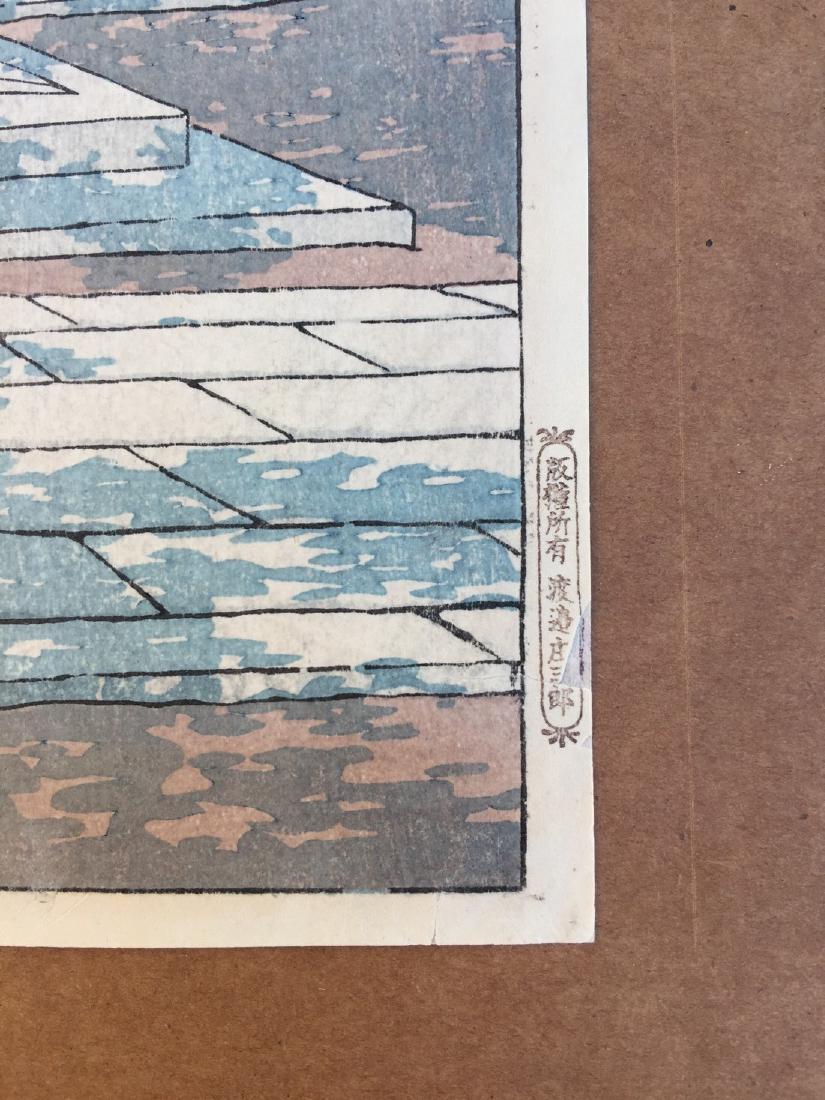 |
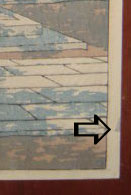 |
The forth example of print doctoring is Tsuchiya Koitsu's "Yaizunohara". I do not know where this print was originally purchased; perhaps someone has further information. To me it is quite obvious that this print is one of the many examples of unsealed Koitsu prints, published between the 1960s to the 1990s, that has had a forged pre-war publisher seal added to the lower left margin. The printer and carver on the (forged) seal are listed as Matsushita and Yamada, respectively. Now that is quite interesting, because the carver, Yamada, did not carve Koitsu woodblocks for Doi after 1934 (Ikeda replaced Yamada as carver in 1934), yet this print was first published in 1937. Furthermore, the printer Matsushita stopped printing Koitsu scenes for Doi in 1935; Matsushita was then succeeded by Yokoi. As such, a true first edition should have a seal with Ikeda as the carver and Yokoi as the printer (see the Koitsu Raisonne for printer and carver time-lines, or other web resources like the Koitsu website). Also note the seal combination Matsushita/Yamada was never used on this scene. In fact, this seal combination was only used on a single Koitsu scene: that of Kyoto Nijo Castle published in 1933. You can see my copy of a genuine first edition strike of Yaizunohara here. Note via the seal on my print that the carver of the first edition was in fact Ikeda (not Matsushita), with printer Yokoi (not Yamada). You can check the Koitsu website for other examples of first editions of this scene; they all have the same seal as my print.
Note that the unfortunate winner of the auction paid $550 for this doctored print, despite the fact it is perhaps worth no more than $150, being the recent edition it is.
| Jasper52 Auction print | ||
| Front | 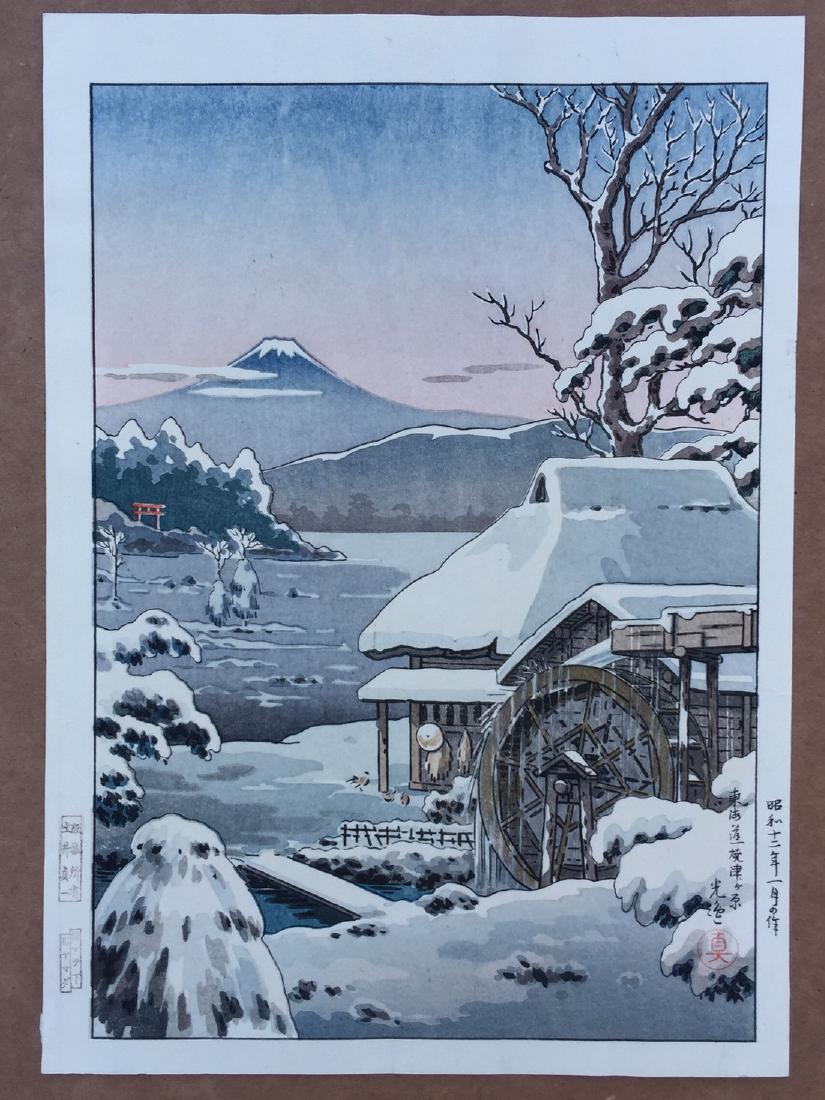 |
|
| Note the poorly forged publisher seal in the lower left margin that also contains the Yamada carver and Matsushita printer seals. Note that the carver, Yamada, did not carve woodblocks for Doi after 1935, yet this print was first published in 1937. Also note the seal combination Matsushita/Yamada was never used on this scene. In fact, this seal combination was only used on one Koitsu scene: "Kyoto Nijo Castle". You can see my copy of a genuine first edition of this scene here. Note that the carver of the first edition was in fact Ikeda (not Yamada), with printer Yokoi (not Matsushita). | 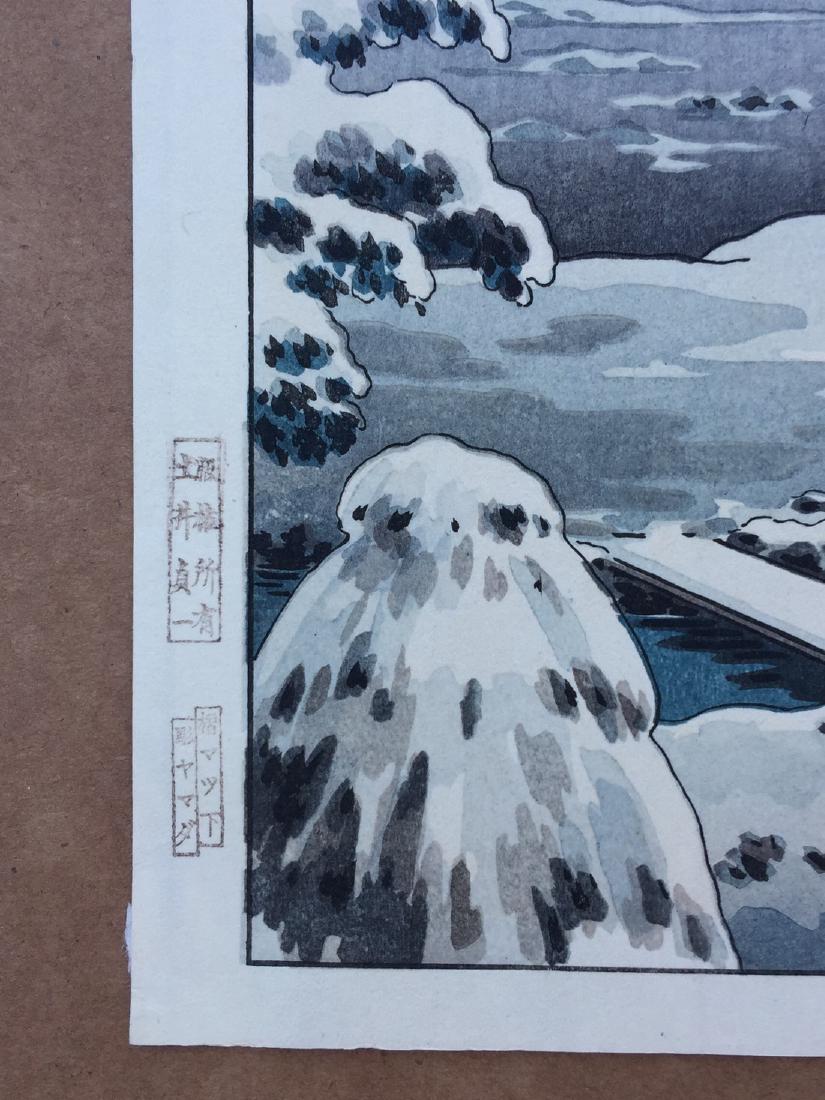 |
Here is one example of the Tsuchiya Koitsu print, Benkei Bridge, that has been, I believe, "doctored" with not one but two fake seals: one being the publisher seal and the other being a "Tokyo Views" series seal that was used only on first editions. Now I should know a thing or two about this particular scene, because I have about 30 copies in my collection, from first editions to recent re-strikes, so for me (and most Koitsu connoisseurs I would suggest) it is reasonably easy to determine whether a print is a pre-war edition or a recent edition, even without seeing the publisher seals. In the print below, I see nothing other than one of the many un-sealed Koitsu prints that were printed between the 1960s and the 1990s; as most Koitsu collectors would know around 20% of his prints were sold, most likely clandestinely, without publisher seals. Like the Koitsu "Yaizunohara" print above, the bright white washi paper is usually an obvious sign of a recent edition, as is the poor printing quality and the block wear. Take a look at any of my Koitsu pre-war editions here and you will notice nothing other than fine tight printing and crisp keyblock lines from blocks that show little to no wear, with the washi paper having at least a mellow toning only the passage of age can provide. Please note the poorly carved publisher seal in the left margin, and the glaringly fake series seal in the middle of the right margin.
| Live Auctioneers, Woodblock Prints World Auction print: Tsuchiya Koitsu's Benkei Bridge, Update 2017 March 31: As expected, the dealer has now hidden his forgery and changed the print on the website to one that is a later edition. Here is a link to a PDF of the original web page, where you can clearly see the print that is currently on the website is clearly not the print that was there a few days ago. |
||
| Front | 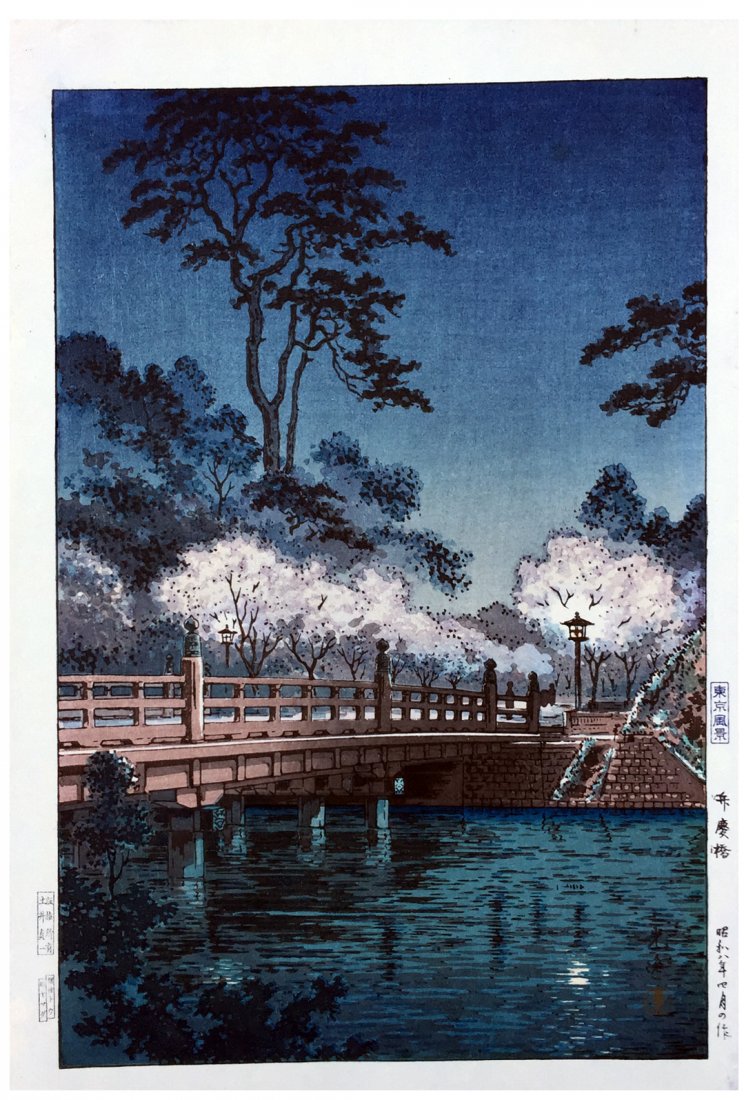 |
|
| Once again we note a poorly forged publisher seal in the lower left margin. | 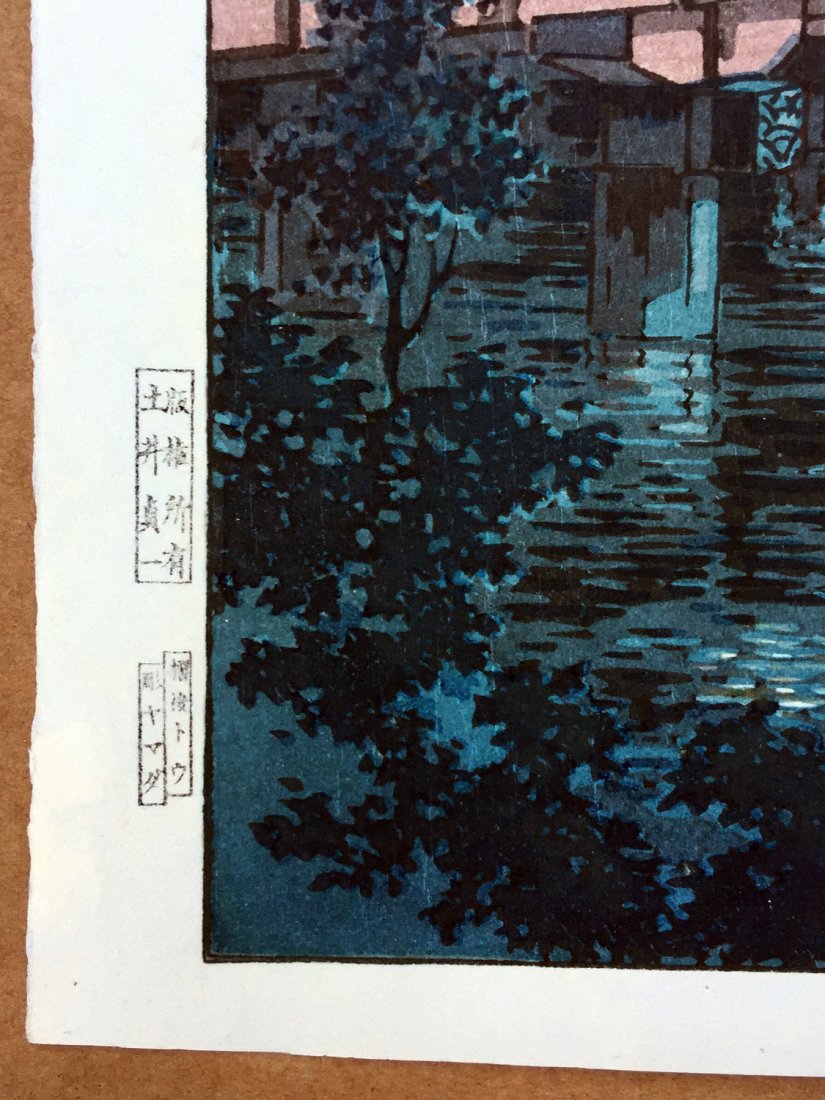 |
|
| Here we have a poorly forged "Tokyo Views" series seal in the mid-left margin. Also note the bright white paper and sloppy printing quality (a good example is the title kanji in the margin), both of which you will never see on pre-war strikes. | 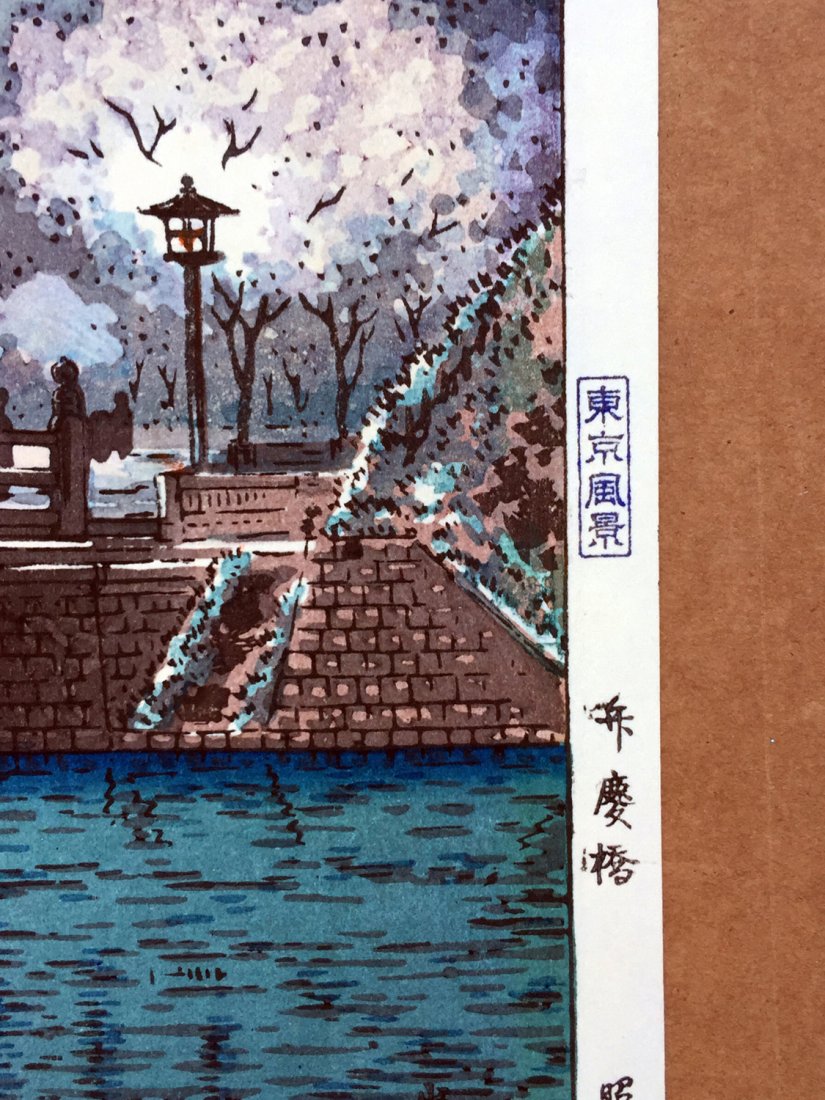 |
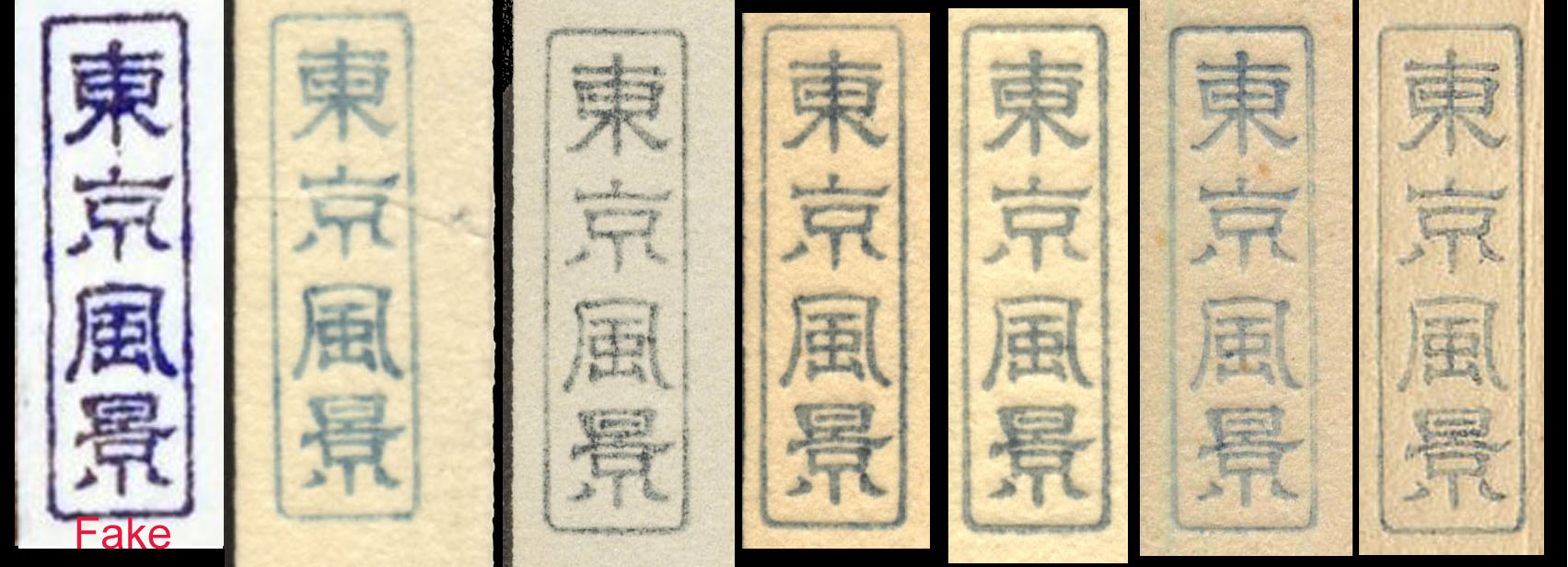 A comparison of the Woodblock Print World "Tokyo Fukei" seal (on the left) with six genuine seals taken from first edition Tsuchiya Koitsu prints. There are several salient features that make the seal at left an obvious fake; can you spot them?. I'm not going to mention those features in this report for fear of "training" the seller to make "harder to detect" fake seals; just email me if you can't see them yourself. |
| Invaluable Auction's Igal M. Atelier Auction print | ||
| Front | 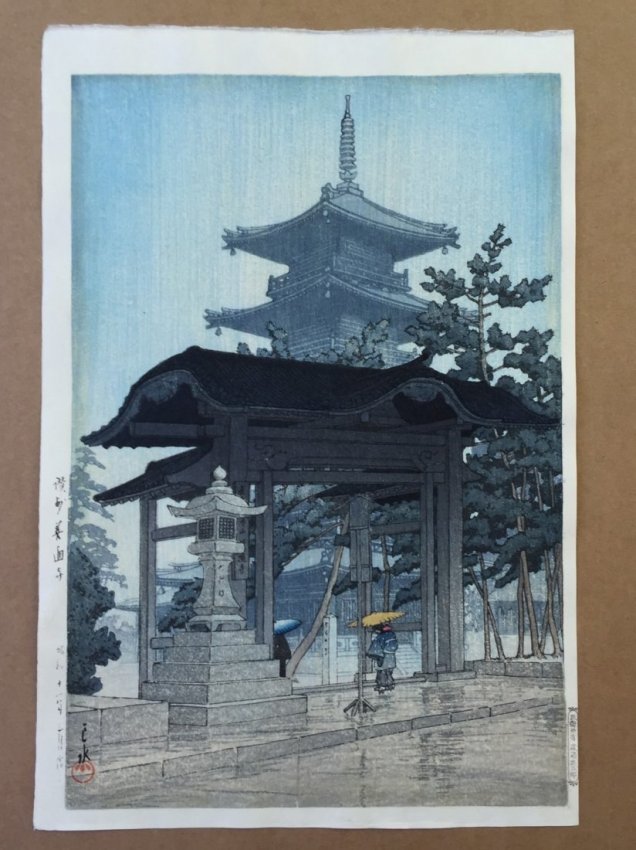 |
|
| Once again we note the poorly forged publisher seal in the lower right margin. This is the same forged seal that was applied to Hasui's Snow at Mukojima and Hasui's Fudo Temple in Meguro discussed above. | 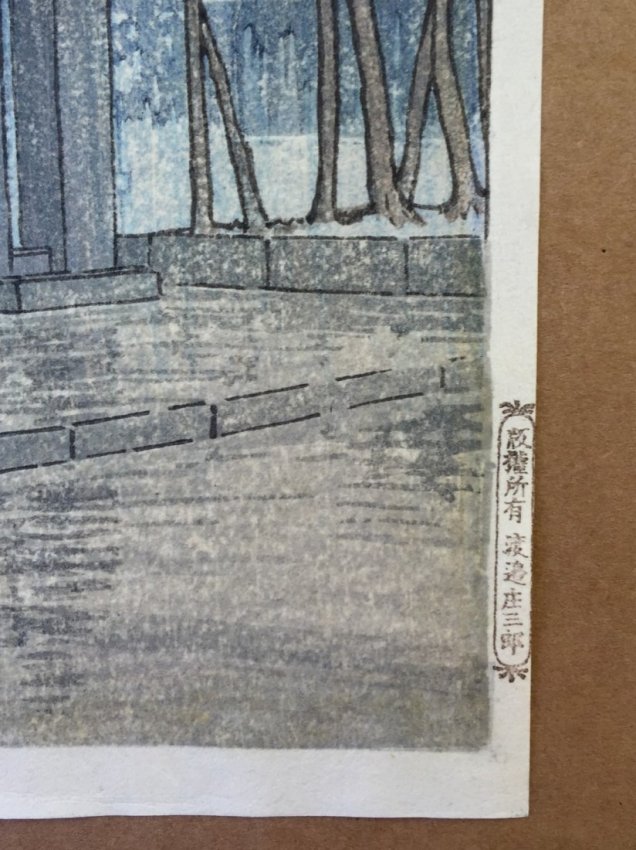 |